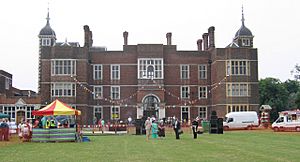Sir Adam Newton, 1st Baronet facts for kids
Sir Adam Newton (died 1630) was an important Scottish scholar and teacher. He worked for the royal family, teaching young princes, and later became a high-ranking church official and a special kind of noble called a baronet.
Life of Sir Adam Newton
Adam Newton spent some of his early life in France. He worked as a teacher at a college in a place called Poitou, sometimes pretending to be a priest. Between 1580 and 1590, he taught Greek to a future famous religious scholar named André Rivet.
Around 1600, after returning to Scotland, he became a tutor to Prince Henry. Prince Henry was the eldest son of King James VI of Scotland (who later became King James I of England). Newton taught the prince at Stirling Castle. In 1602, he even bought books for the prince from a bookseller in Edinburgh.
When King James became King of England in 1603, Newton moved to England with the royal family. He became an English citizen in the first English parliament held by King James. In 1605, the King helped him get a special job as the dean of Durham. A dean is a high-ranking church leader, even though Newton was not a priest himself. Someone else likely did the actual duties for him.
In 1606, he bought a large estate in Charlton, Kent, where he built a grand house called Charlton House.
Sir Adam Newton continued to teach Prince Henry until 1610. When Prince Henry became the Prince of Wales and got his own royal household, Newton was made his secretary. After Prince Henry sadly passed away in 1612, Newton became the treasurer for Prince Charles, who was the next in line to the throne. He kept this job until he died.
In 1620, he was given the title of baronet. This was a special honor from the King. To get this title, he sold his deanery job in Durham. After Charles became King, Newton also became secretary to the King's council. In 1628, he became secretary for the Marches of Wales, which was a very important and well-paying job.
Sir Adam Newton died on January 13, 1630. In his will, he asked his friends to use some of his money to rebuild a nearby church called St Luke's Church in Charlton.
Sir Adam Newton's Works
Adam Newton translated some important books into Latin. He translated King James's book called Discourse against Vorstius. He also translated the first six books of a history book about the Council of Trent, written by Paolo Sarpi. This translation was published without his name on it in London in 1620.
Sir Adam Newton's Family
In June 1605, Adam Newton married Katherine Puckering. She was the youngest daughter of Sir John Puckering, who had been a very important official during the time of Queen Elizabeth I. Katherine's brother, Thomas Puckering, also studied with Prince Henry under Newton's teaching. King James gave Adam and Katherine a special gift of silver dishes.
Elizabeth Newton, Adam's wife, died in 1618. They had several children, including:
- Henry Newton, who later took his mother's family name, Puckering. He became Sir Henry Puckering, 3rd Baronet, inheriting titles and lands from his uncle Thomas Puckering in 1654.
- Elizabeth Newton, who married Edward Peyto in 1625.
- Jane Newton, who married James Enyon.



